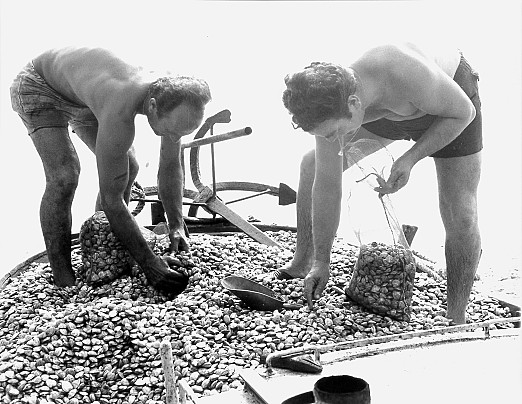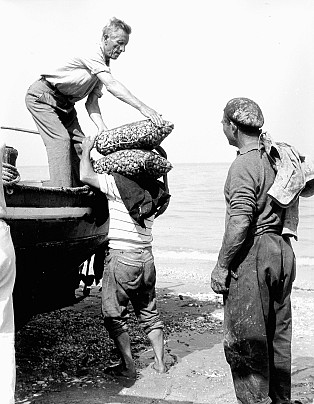La civiltà marinara - Maritime civilization
LE IMBARCAZIONI NELLA STORIA
Le Concolare devono il loro nome alla concola (dal latino conchola) utilizzata nella nostra Regione in sostituzione del termine napoletano vongola.
La pesca delle concole iniziò nel 1926, quando venne costruita la prima concolara ad opera del maestro falegname Egidio Taffoni. Dopo la Seconda Guerra Mondiale alcune imbarcazioni, grazie ai Fratelli Ciarrocchi, applicarono i motori, aumentando la quantità del pescato e la sicurezza degli uomini in mare.
Negli anni Settanta si costituì una cooperativa di pescatori di vongole, attiva fino a qualche decennio fa, che ha posto Cupra all’attenzione del mercato nazionale e internazionale del settore.
La pesca della Sciabica veniva praticata in primavera e in estate; si trascinava una grossa rete formata da un sacco centrale e da due lunghe ali tenute a galla da sugheri ed era un’operazione in quattro fasi nelle quali la rete veniva stesa, calata in mare e ritirata a terra assieme a una grande varietà di pescato. Dagli anni Settanta in poi, la sciabica è stata proibita.
La Nassa è un attrezzo di canne, giunco e reti intrecciate chiuso, di forma ovoidale con un’apertura che consente l’ingresso, e non l’uscita, di seppie e crostacei. Il periodo di pesca era da aprile a giugno.
La Lancetta è un antico peschereccio cuprense, imbarcazione con albero, bastone e una vela triangolare chiamata fiocco.
I Trabaccoli, imbarcazioni da trasporto, erano dei barconi tozzi che da Cupra partivano verso l’Adriatico. Ce n’erano poco più di una decina tra Ancona e la nostra città, quelli più grossi erano a Civitanova e a Cupra Marittima. Nel 1924 si passa al motore, grazie a un’intuizione di un componente della Famiglia Censi. L’ultimo dei trabaccoli cuprensi ha navigato fino all’inizio degli anni ’40.
BOATS IN HISTORY
The Concolare owe their name to the concola (from the Latin conchola) used in our Region to replace the Neapolitan term “vongola” (clam).
Concole fishing began in 1926, when the first concolara was built by the master carpenter Egidio Taffoni. After the Second World War some boats applied engines thanks to the Ciarrocchi Brothers, increasing the quantity of fish and the safety of men at sea.
In the seventies, a cooperative of clam fishermen was formed, active until a few decades ago, which brought Cupra to the attention of the national and international market in the sector.
Seine fishing was practiced in spring and summer; a large net made up of a central bag and two long wings kept afloat by cork trees was dragged and it was a four-phase operation in which the net was spread, lowered into the sea and withdrawn to land together with a large variety of catch. From the 1970s onwards, seines were prohibited.
The Nassa is a closed, ovoid-shaped tool made of reeds, rush and woven nets with an opening that allows the entry – not the exit – of cuttlefish and crustaceans. The fishing period was from April to June.
The Lancetta is an ancient Cuprense fishing boat, a boat with a mast, stick and a triangular sail called a jib.
The Trabaccoli (transport boats) were squat boats that set out from Cupra towards the Adratic. There were just over a dozen of them between Ancona and our city. The largest ones were in Civitanova and Cupra Marittima. In 1924, they switched to the engine, thanks to an intuition of a member of the Censi family. The last of the Cuprensian trabaccoli (luggers) sailed until the early 40s.

































